Language and Literature
Montessori Elementary Language and Literature Curriculum
Language Arts
In Lower Elementary (1st – 3rd grade, ages 6-9), students acquire the foundational skills (e.g., handwriting and reading fluency, phonics, and spelling) they need to become capable writers and engaged readers. The Montessori Upper Elementary (4th – 6th grade, ages 9-12) program builds on these skills and guides children to acquire clarity and sophistication in thought and communication, both oral and written.
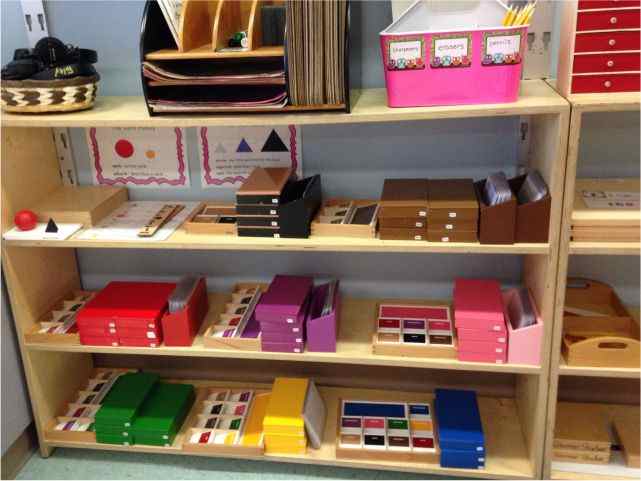
“I am a professor, and I really appreciate Vruksha’s writing program. It’s really unique: because they have very high standards, the kids will do many re-writes of their assignments. And that’s how they actually learn—by doing draft after draft, correcting their mistakes, and learning to become better writers in the process. Many schools just can’t do that—and what does a child learn, when he writes something once, then gets a grade, and that’s it?!”
by Vruksha ParentLanguage Arts: What Your Child Study?
Explicit phonics and handwriting early on, transitioning to spelling, vocabulary, grammar and writing process in the upper elementary years
In our Montessori elementary classrooms, writing and reading are everywhere, and we invest in coaching each student one-on-one, every day. Our language arts program has several main components.
Writing mechanics in Lower Elementary
Our goal is to graduate students who have become proficient in the basic process of writing. We teach neat, fluent handwriting (especially to students who join us from outside, without Montessori Primary experience). Our students practice cursive writing from day one (as against the common public school practice of teaching block letters, and then re-training students to cursive in grade 3). As students start writing sentences, we introduce the mechanics of punctuation, capitalization, where to place sentences on the page, and how to construct well-written paragraphs.

Grammar
Grammar is the structure of language. At Vruksha, we present grammar simply and coherently, using unique Montessori grammar materials which help students visualize parts of speech (verbs, nouns, adjectives, etc.) with colorful symbols (a red circle is the active verb, a black large triangle the noun, and smaller triangles in light and dark blue as the articles and adjectives, for example). We guide students to analyze sentences and understand the role of words within a sentence (subject, predicate, object, etc.), using Montessori materials early on, and adding in sentence diagramming in the upper elementary grades.
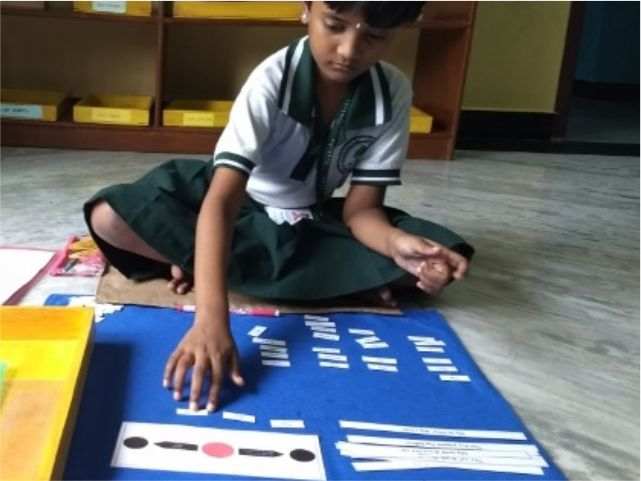
Reading for skills
Once our lower elementary students learn to decode words with ease (which they do quickly with our phonics-based program), we systematically build their comprehension skills. We show them how to use dictionaries to look up unfamiliar words, enabling them to build their own vocabulary lists. We use a systematic “Reading for Understanding” program, which allows each child to progress at their own pace, and guides them to read for meaning across a variety of subjects, from science to sports. As they read these passages, they learn vocabulary, comprehension skills, and fluency, all while acquiring a broad range of background knowledge essential for reading comprehension.
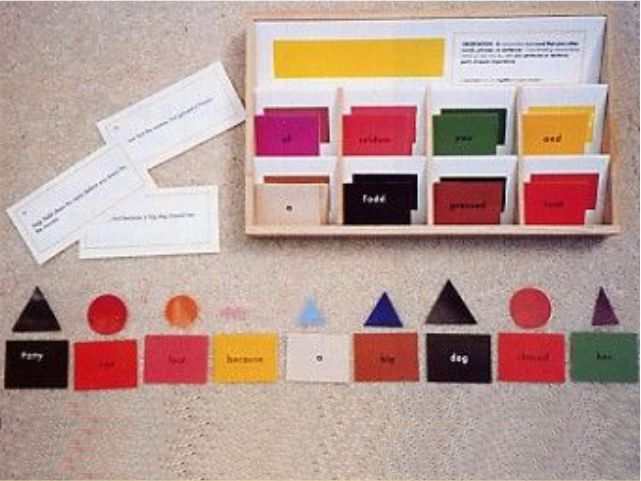
Reading for content
Once students are readers, they read everywhere in our Montessori classrooms. They do research in history. They read science experiment instructions. They read about different cultures in geography. They learn that reading is a key means to discovering the answers to questions that are meaningful to them.

Applied writing
We believe good writers are made, not born. In Lower Elementary, writing is often about volume, because writing a lot helps children achieve comfort and fluency. Our teachers excel at encouraging students to write about subjects they care about, whether that’s research on animals or countries, or famous people, or creative stories. As children mature, our teachers support them with careful instruction in writing. With our Institute for Excellence in Writing program, children learn to brainstorm ideas, develop keyword outlines, and learn to use their expanding vocabulary to write compelling sentences. They practice editing their own work, and that of peers, and write multiple drafts, first by hand, and then later by typing them up on school-provided computers. Throughout, our teachers review each piece of writing—providing immediate, tailored feedback to each child. We never just grade a piece of work and then have the child put it away; our students continuously correct their mistakes and actively learn from them. The result? Children who don’t feel daunted by a white sheet of paper, but instead have the confidence of solid skills—and the repeated experience of producing a finished product that makes them proud!
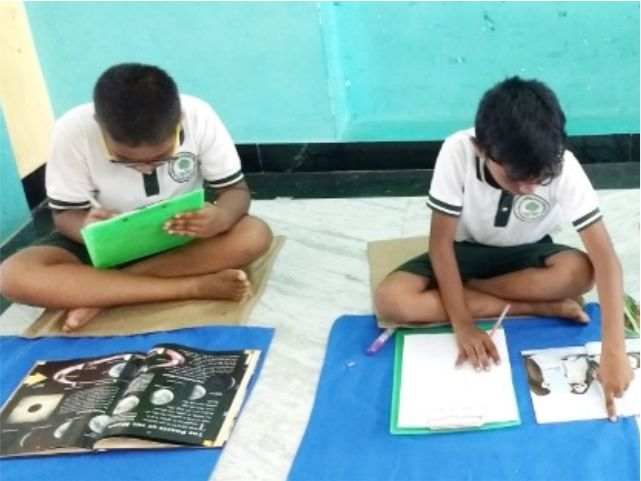
Word study, vocabulary development, & spelling
In Lower Elementary, our students build their vocabularies and improve their spelling primarily through word study activities. By understanding common suffixes and prefixes, students are given a tool for interpreting and decoding a range of words. With hands-on word building materials, students explore compound words and root words. In Upper Elementary, spelling practice takes a variety of forms, depending on the needs and abilities of individual students. Students may use lists that focus on specific spelling concepts (e.g., the different ways of making the long [a] sound). They may make posters or use spelling command cards, or they may use an auditory spelling program. Vocabulary development continues, with an emphasis on understanding Latin and Greek roots of many of the words in our language. Our students are encouraged to not memorize definitions—but to understand the meaning of new words, and to actively use them in their own writing.

Reading for pure enjoyment
Most children of parents who consider a school like Vruksha will learn to decode and become decent readers. But will they love reading—and continue to read, outside of class and for pure interest in adulthood? In Montessori Elementary, we ensure that reading is joyful and rewarding. Children have time for free reading books of their choice—without any required reading logs or book reports. Teachers regularly read aloud to children, from a variety of authors and genres—including poetry and plays—and share their own love of the written word.
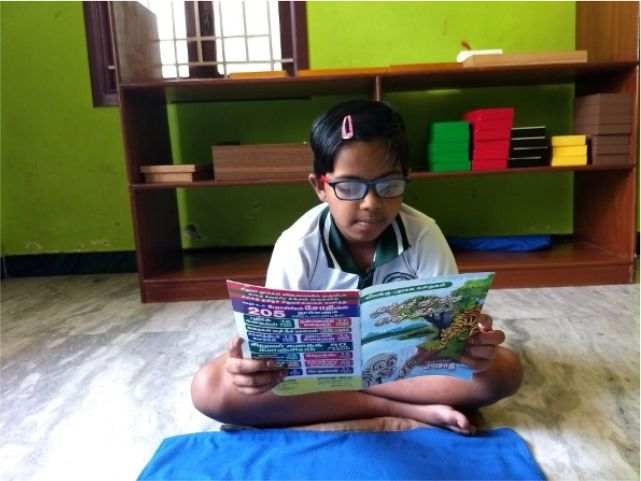
“My daughter became a reader at Vruksha. Before she got to Vruksha, she almost never read. The summer before she entered Vruksha, I taught her grammar, so she could catch up with her class. She became very interested in spoken language, and then she started reading eagerly for class, and then on her own. She even delighted in correcting my grammar at times! To this day, I am surprised how often she’ll just take a book to read and by the level of what she chooses to read.”
by Vruksha ParentFor Your Deeper Understanding
"Word Study Work" in Lower Elementary
 Six- to nine-year-old children are eager to understand
language in context. They love playing with words, especially if they can do so with peers!
We leverage that playful, joyful eagerness in the Word Study program of Montessori Lower
Elementary. We guide children in taking apart words to identify their components—and set
them free to find many types of words to which they can apply their skills.
Six- to nine-year-old children are eager to understand
language in context. They love playing with words, especially if they can do so with peers!
We leverage that playful, joyful eagerness in the Word Study program of Montessori Lower
Elementary. We guide children in taking apart words to identify their components—and set
them free to find many types of words to which they can apply their skills.
Children learn about affixes (suffixes and prefixes), compound words and word families.
In each topic, we get children started with a limited introduction to a few examples
(select suffixes, a few sample compound words, some root words) then encourage them to
embark on their own work. This open, exploratory approach encourages children to engage
actively, to persist—in contrast to close-ended assignments such as worksheets, which
imply that once complete, the work is done. As the elementary years are social years,
children often work together in group, and take great delight in sharing their newest
word discoveries with each other, or quizzing each other on the words they have learned.
Suffixes are affixes which are added to the end of a base word or root. They frequently signify the part of speech, and sometimes add meaning (e.g., quiet (adjective), quietly (adverb), quietness (noun)). Suffixes are one of the first word study activities introduced, because children can more easily identify the ending of a word, helped by intonation.
Prefixes are affixes added before a base word or root. Each prefix has its own meaning, and changes the meaning of a word accordingly (e.g., mid (middle)—midnight, midway, midsummer).
Compound words are words made of two or more words, each of which has a meaning of its own (e.g., butterfly — it’s not butter put on a fly, something which elementary age children find very funny!).
Word families — introduced later in the program—are groups of words which come from the same root or origin, often from other languages such as Latin and Greek. The study of word families often leads children to the study of the origin of words, and is related to the study of etymology, which is part of many lessons for children in the elementary years.
Word study helps children acquire many skills:
Reading skills: By breaking words apart into smaller elements, children become better readers, more readily able to decipher and make sense of unfamiliar words.
Spelling skills: By identifying patterns, word study helps children become better spellers—especially important in English, where the sound-spelling correspondence isn’t as clear as in more phonetic languages like Spanish or German.
Vocabulary development: By searching for words for their word lists—in their reading materials, in dictionaries—children acquire an astounding amount of vocabulary, joyfully, without mindless drills.
Handwriting: While younger children often use the Moveable Alphabets to build words—especially for suffix and prefix study, where the affixes are made with differently colored letters—older children also practice writing with these exercises.
Grammar in upper elementary
Aid to creative writing and rational arguments
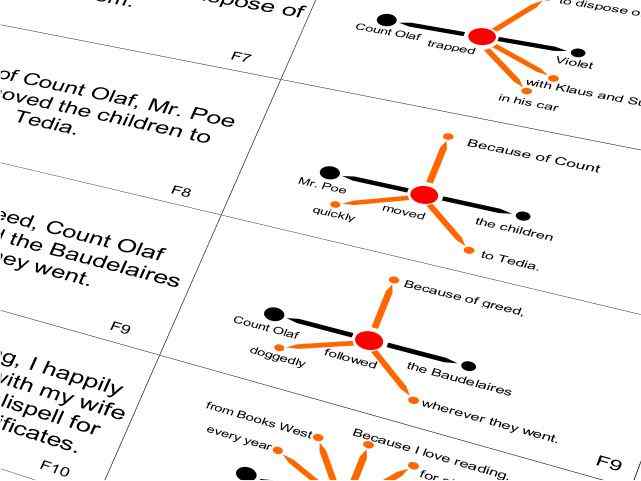 In Montessori Upper Elementary, students deepen their study of grammar. Instead of looking at
words in isolation (e.g., “this is an adjective, this is an adverb”), the attention shifts
to the relationship of words within sentences.
In Montessori Upper Elementary, students deepen their study of grammar. Instead of looking at
words in isolation (e.g., “this is an adjective, this is an adverb”), the attention shifts
to the relationship of words within sentences.
The Montessori Sentence Analysis materials loose wooden circles and arrows—are used to break simple sentences down into their parts.
As sentences become more complex, the amount of circles and arrows needed to represent them would become unmanageable. That’s when we introduce Sentence Diagramming as a paper-on-pencil, more abstract, yet still visual representation of how the parts of a sentence fit together.
9-12 year olds in Montessori Upper Elementary thus acquire tools that help them to:
Review the parts of speech.
Understand how the parts of speech function together to create compound sentences.
Explore methods of joining subjects, verbs and objects.
Understand complex grammatical tools used to make compound sentences, including prepositional phrases, verbal nouns, modifiers and compound subjects.
Throughout the program, we ensure that students apply what they learn, that they see the value of grammar as an aid to improve their creative writing and their thinking skills. For example, once a student realizes that pronouns must have a clear antecedent to be understood, they can be on the lookout for vague pronouns in their own writing. They can ask themselves, “do all my pronouns have clear antecedents?”
We thus teach grammar as a powerful tool for clarity in communications. By explicitly teaching sentence diagramming, we enable students to, in Montessori terms, isolate the difficulty to focus on how the English language works, to practice writing with precision and editing with purpose. Thus, we give students an appreciation for the power of the English language and equip them to be skilled writers, who have at their disposal a well-practiced, intuitive grasp of how to write (and argue!) logically.
Literature: What Your Child Study?
Absorbing great writing by reading great authors, and using literature as a tool for understanding human behavior.
Absorbing great writing by reading great authors, and using literature as a tool for understanding human behavior. Reading great literature gives children the opportunity to enter exciting worlds, to meet heroic characters, and to consider what’s possible in life. While studying the classics of yesterday and today, students not only improve their thinking and communication skills, but also learn important moral lessons—lessons they use to guide their own choices. Our approach to the study of literature is motivated by two core goals—understanding and empathy. We want students to understand what a story means, what the author is saying, and why. We want students to learn to empathize with characters, to understand their circumstances and motivations.
In contrast to some Common Core programs, which focus on book excerpts and informational texts, our students read full-length books. Well-written stories with strong, relatable characters draw students in, and help cultivate a habit of extended, deep reading, a skill that is all but lost in today’s hectic, multitasking environment. We choose books that present a benevolent world-view, not necessarily because they are always happy books but because they offer lessons to learn and opportunities for redemption and growth.
Literature study happens in small groups, like a “book club.” These groups are pulled together from the mixed-age classroom community based on reading levels and interest. Students read carefully chosen chapter books and have structured discussion groups, guided and supported by a teacher. During these group sessions, students learn how to analyze a novel’s plot, discuss the key characters, and identify the theme or deeper meaning of what they read. Lower elementary students may bring home short reading assignments, as well as a few questions to answer and vocabulary to look up. Upper elementary students write longer pieces about the books they study, and at times integrate their literature work with history, as when they read historical fiction set during the period of history they are studying. Throughout, we ensure that our students experience how fun it is to read quality fiction: our goal is not only children who read well—but who love to read and continue that habit for a lifetime.
““Vruksha makes the content of their demanding curriculum interesting, even for children who struggle initially. With his dyslexia, my son never enjoyed readingbut at Vruksha, they got him excited about literature and poetry. In 5th grade, they were doing the Greek myths and these struck a chord with my son. He wanted to learn more and the teachers were always so available, to help him with any reading issues, to talk with him, to look up more materials, to take it one step further. Before Vruksha, my son felt like a loser. At Vruksha, they took him for who he naturally was and showed him how he was a winner. They did not dumb down the materials for him anywhere; they just made them accessible for him in a way that not one of his previous schools did.””
- A ParentHow it Differs?
How Montessori Language Arts Compares to Regular Board School Standards
In the Montessori Elementary program at Vruksha, by 6th grade, your child will meet or exceed the standards expected in public schools for language arts while remaining a joyful, eager learner, and without hours of homework each night.
Here are some examples of how Montessori Elementary Language compares:
| Area | Points of Comparison |
|---|---|
| Handwriting |
Cursive and print handwriting. At Vruksha, students learn to write in
cursive from preschool, and add in print. We introduce keyboarding in
4th grade. Often, public schools only teach print, not cursive.
|
| Writing |
Extensive editing of writing. Vruksha students edit, edit, edit—so they
improve their work, and deliver writing that is clear, concise, and compelling.
This contrasts with the “one and done” approach in some public schools.
|
| Grammar |
|
| Word Study (vocabulary & spelling) |
|
| Literature |
tudy of full-length novels, chosen from classics of today and yesterday.
In contrast to many programs which largely study text excerpts,
at Vruksha your child will read several full-length novels each year.
|
Get in Touch with Us
Our Headquarters are in Chennai and Puducherry
27-28, 2nd Cross
Moogambigai Nagar
Reddiarpalayam, Pondy - 605 010
Phone: +91 9994851951
Phone: +91 9361919996
Email: contact@vrukshamontessori.com
24-25, 12th Cross
Ranga Reddy Gardens
Neelankarai, Chennai - 600 041
Phone: +91 9994851951
Phone: +91 9361919996
Email: contact@vrukshamontessori.com
